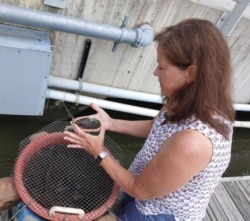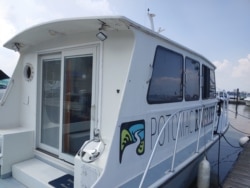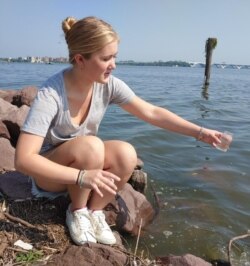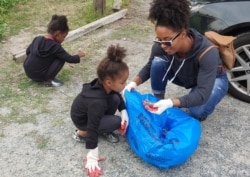Emily Franc lifts a round basket out of the Potomac River at National Harbor in Oxen Hill, Maryland, just outside Washington. Inside are freshwater mussels, a shellfish that used to be plentiful in the Potomac River a century ago.
But not anymore.
“Millions of mussels were in these waters when they started dying off sometime over the past century, but we are not sure why,” said Franc, vice president of development and philanthropy for the Potomac Riverkeeper Network, an environmental organization working to protect the water quality of the river.
“What we do know is that that the mussels were being overharvested for their shells which were made into buttons,” she told VOA.
Now, a project is underway to restore native freshwater mussels to the Potomac to improve water quality. The river provides drinking water for 6 million people.
“The aim is to restore 50 million mussels to the river by 2030,” Franc said.
Currently, the project is in the early stages.
“A couple of dozen mussels are being suspended in baskets above the river bottom – a kind of mussel nursery where we can monitor them and better ensure their survival,” Franc said.
"The long-term goal is to begin getting the mussels to breed on their own,” added Dean Naujoks, the riverkeeper who keeps watch over the Potomac river.
The scenic 650-kilometer-long Potomac river flows through Maryland, Virginia, West Virginia and Washington, D.C.
Despite its beauty, the river has been experiencing environmental degradation for years.
Once considered one of the dirtiest rivers in the country, cleanup efforts, public education and laws to protect the country’s waterways, have helped to improve water quality.
However, pesticide runoff from farms and lawns continues to make its way into the river. In addition, in the Washington area, contaminates from streets get in the waterway, as does sewage after heavy rainstorms due to an aging water and sewer infrastructure.
The pollutants that are bad for the river are some of the very things mussels use to get their nutrition.
The shellfish removes harmful algae and bacteria, as well as toxins and sediment from the water.
“They like nutrients like nitrogen and phosphorous, so they are helping to remove excess chemicals, like fertilizer on our lawns, that run off into the river,” Franc said.
If the program is successful, the water quality in the Potomac is expected to greatly improve in the future.
“These mussels alone should filter about 18 million gallons [68 million liters] of water over a single year,” Washington’s water utility, DC Water, said on its website.
The Potomac River Network keeps tabs on the water quality. Volunteers take water samples in various places along the river.
As 16-year-old Emma Carter fills a small bottle with water in Alexandria, Virginia, told VOA, “what surprises me if how different the water samples are depending on where they were taken. You would think they would all be the same, but they aren’t.”
The samples are analyzed for E.coli, bacteria from fecal contamination in the water.
“Our data showed dangerous levels of E.coli in areas near combined sewer overflows that discharge raw sewage when it rains,” a report from the riverkeeper network said.
Besides gauging the health of the river water, the information is used to let people know where it may be safe to swim in the Potomac.
Another initiative to help keep the river clean is encouraging volunteers to come to trash pickup events.
Nadia Coleman searches for floating garbage from a kayak in Alexandria.
“Every time I come out here I find cans, plastic water bottles and take-home food containers -- and even came across someone’s boot today.
Franc is especially concerned about pollution from the water bottles.
“They break down into very small pieces and the birds, fish, and other animals eat it thinking it is food,” she said. “Their stomachs get full and they starve to death. The chemicals in the plastic gets into our drinking water supply.”
Naujoks said he would like to see “trash traps installed in Potomac tributaries, to keep the garbage from getting into the river that so many people enjoy for recreational activities like boating and fishing.”













